Recent Articles
Popular Makes
Body Types
2025 Ford Mustang Mach-E vs. 2024 Honda Prologue
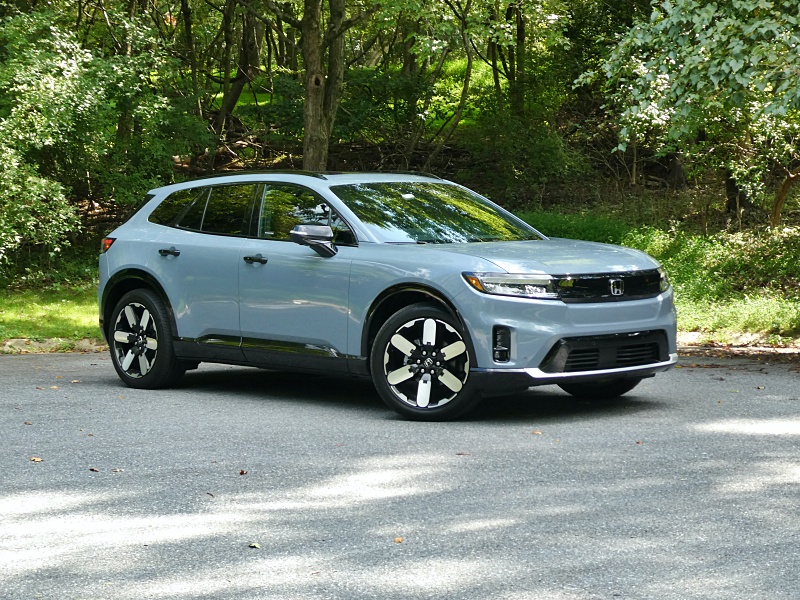
2024 Honda Prologue Elite ・ Photo by Brady Holt
The new 2024 Honda Prologue has been taking the electric-car market by storm. This mid-size crossover SUV – derived from General Motors’ Chevrolet Blazer EV – quickly became one of the best-sellers in its class. It pairs the efficiency and quiet speed of an EV with the simplicity of an ordinary car, rather than a high-tech gizmo.
But the 2025 Ford Mustang Mach-E, on sale since 2021, remains a formidable contender in this class. This retro-styled crossover has iconic styling and the performance to match it – along with more interior room than you might expect.
For this review, we’ve tested both the Prologue and the Mustang Mach-E to see how they compare in each of 10 categories and then name an overall winner. Keep reading to see which one we picked and which one seems like the right electric crossover for you.
Pricing and Features
The new Prologue starts at $47,400 versus $36,495 for the Mustang Mach-E. And that’s despite the Ford’s standard leatherette upholstery versus the Honda’s cloth seats.
A few points do level the playing field a little. First, only the Honda is available with a $7,500 federal tax credit as we write this article in early January 2025. Taken at the point of sale, that drops the Prologue’s starting price to $39,900. Second, you have to pay extra for a bigger battery in the Mustang, while you get the Prologue’s maximum 296-mile range per charge even in its base model. (We’ll talk about range more soon.) Third, many EVs’ prices vary widely from the sticker price depending on the dealership and on the day’s lease deals. So you’ll want to check numbers with your local dealers at the time of purchase.
Still, we’ll award this category to the Ford overall. Not only does it have the lower sticker price even accounting for the tax credit, but it also has a broader model lineup that makes it easier to choose the amenities and powertrains you want. The Prologue gives you a choice of two-wheel and all-wheel drive, while the Mach-E also has four tiers of horsepower and two battery sizes.
Winner: Ford Mustang Mach-E
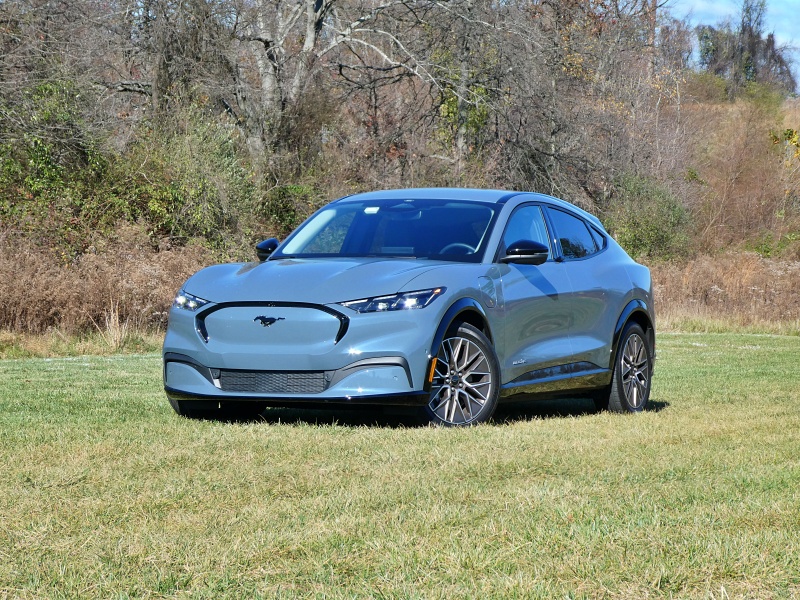
2024 Ford Mustang Mach-E Premium ・ Photo by Brady Holt
Range and Charging
As we mentioned, the Prologue comes standard with 296 miles of range per charge in EPA testing. That’s with a single electric motor that powers the front wheels. Adding the second motor for AWD cuts range slightly to 281 miles on most models. The top Elite trim level (like our test vehicle) gets enormous 21-inch wheels rather than the other trims’ merely big 19-inchers, and they cut the EPA-estimated range to 273 miles. We did handily beat that estimate, on track to hit 318 miles in a week of mixed driving.
The Mustang Mach-E has a wider range of, well, ranges. The base rear-wheel-drive model goes an estimated 250 miles per charge, and adding AWD cuts that to 230 miles – pretty low for an EV these days. And so equipped, our AWD test vehicle was on track for less than 200 miles per charge. But for roughly $3,000 to $5,000 extra, depending on the trim level, the Mach-E lets you opt for an “extended range” battery with excellent EPA estimates of 320 miles with rear-wheel drive or 300 miles with all-wheel drive. That lets the Mach-E win this category. (The maximum-performance GT and Rally models go 280 and 265 miles, respectively.) For 2025, the Mach-E adds a heat pump that doesn’t change the EPA estimates but improves real-world range in cold weather.
Ford also stacks up well for charging speed. Both the Prologue and the Mach-E can recharge from 20 percent to 80 percent in about half an hour at a DC fast charging station. At a 240-volt car charger, like you’d install in your garage or find at some public stations, can fully recharge the battery overnight in both cars. Or you can add a couple miles per hour of charging even on a 120-volt three-prong outlet.
Winner: Ford Mustang Mach-E
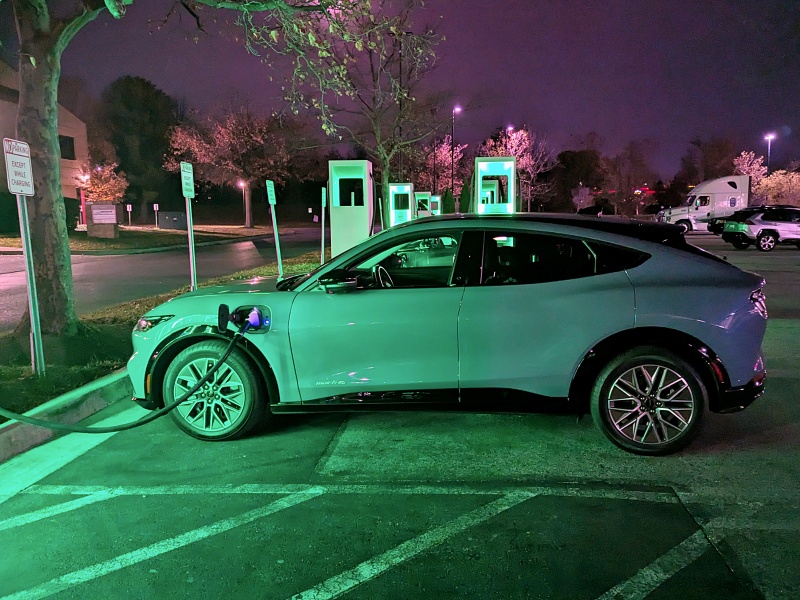
2024 Ford Mustang Mach-E ・ Photo by Brady Holt
Exterior Design
The Mustang Mach-E’s design hasn’t changed since its debut, but it’s still a head-turning EV. While most rivals either look like futuristic space pods or like ordinary cars that happen to be electrically powered, the Mach-E turns the classic Mustang sports coupe into a low-slung crossover. It’s sleek, sporty, and distinctive.
The Prologue, meanwhile, is a Chevrolet Blazer EV dressed up in Honda clothing. It’s low and wide with a long wheelbase and short overhangs. But Honda softens this road-hugging stance with a gentle-looking face that could have been plucked from one of the brand’s five-year-old sedans. If the Mustang looks too wild for your tastes, the Prologue offers a mild way to drive electric. We won’t declare a winner in this fully subjective category.
Winner: Tie
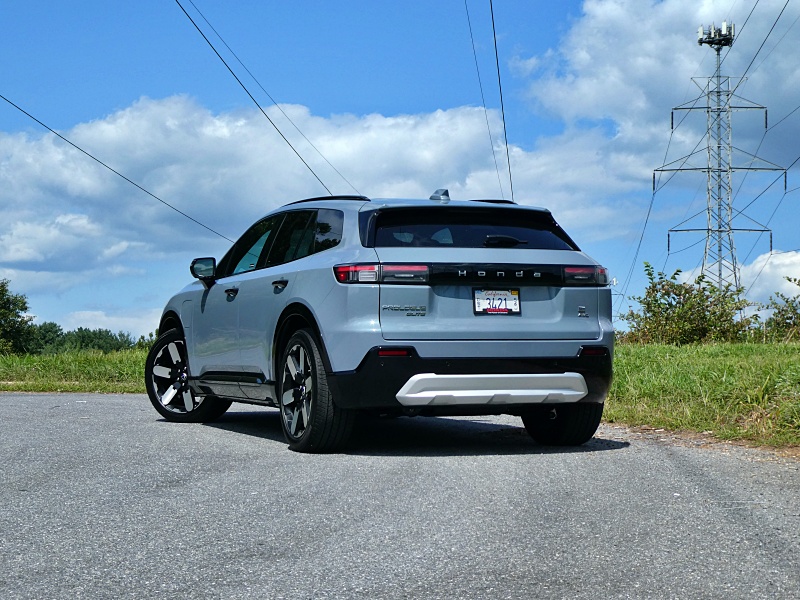
2024 Honda Prologue Elite ・ Photo by Brady Holt
Interior Design
Inside, the Mustang Mach-E adopts the mindset that EVs must be high-tech vehicles with huge dashboard screens – in this case, a 15.5-inch unit that sits vertically on the dash. Unlike a Tesla, Ford still provides some physical buttons, knobs, and stalks. It also has a small secondary digital display for the speedometer in front of the driver. And the infotainment system supports Android Auto and Apple CarPlay smartphone integration. For 2025, Ford replaced our 2024-model test vehicle’s rotary gear selector with a unit mounted to the steering column (like on the Prologue) to create more storage space.
The Prologue, meanwhile, aims for familiarity than high-tech dazzle. Using GM bones and GM parts, Honda assembled a dashboard that fits into the brand’s typical styling language. Like on a Honda CR-V, the slim dashboard includes a strip that incorporates rectangular climate vents. An 11.3-inch infotainment touchscreen perches above that, facing forward. Buttons and knobs for the climate controls sit below. And an even bigger digital gauge cluster than the Ford’s is behind the steering wheel. Like the Ford (though not its own Blazer cousin), the Prologue supports Android Auto and Apple CarPlay. Neither the Honda nor the Ford has the slickest infotainment in the business, both have a few controls that are fussier than we’d like, and neither interior offers luxury-grade decadence.
We’ll call this another overall tie – once again, you’ll choose your flavor between the Mustang’s flash and the Prologue’s simplicity.
Winner: Tie
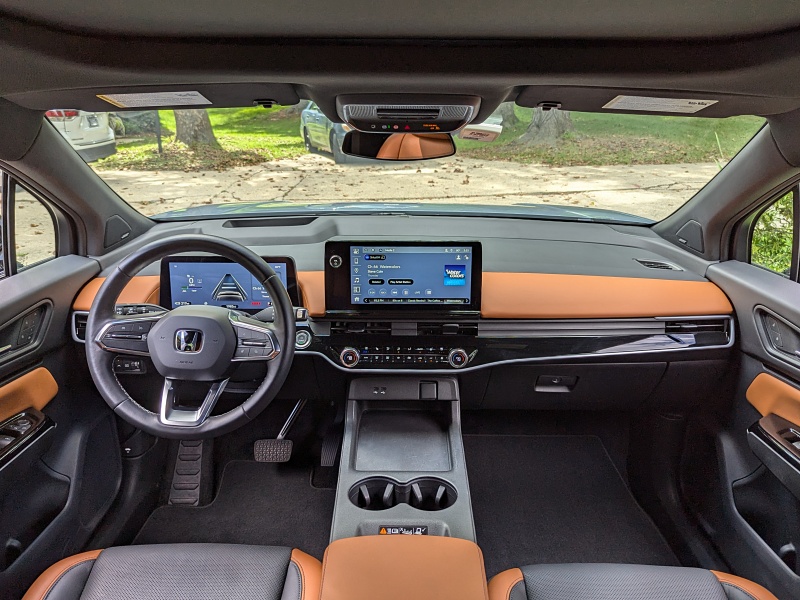
2024 Honda Prologue Elite ・ Photo by Brady Holt
Passenger Accommodations
You might think the Mustang Mach-E’s sporty looks would compromise its passenger space and comfort. Instead, we found this Ford quite roomy and comfortable. The seats are cushy and well-shaped, and even the backseat is adult-friendly. All but the base model comes standard with heated and ventilated front seats plus a heated steering wheel – especially useful in an EV, since heating or cooling the entire cabin cuts into your range. (The base Select model also includes heated front seats and a heated steering wheel, though not ventilated front seats, as part of a $1,500 Comfort Package.)
The Prologue is comfortable inside, too, but the seats’ shape and padding didn’t wow us like the Ford’s. Ironically, the humbler-looking Honda is harder to see out of than the flashy Ford, too. And while heated front seats are standard on the prologue, you need the top Elite trim level to get a heated steering wheel or ventilated front seats. The Prologue’s old-fashioned door handles are simpler than the Mustang’s electronic releases, but otherwise, the Ford wins.
Winner: Ford Mustang Mach-E
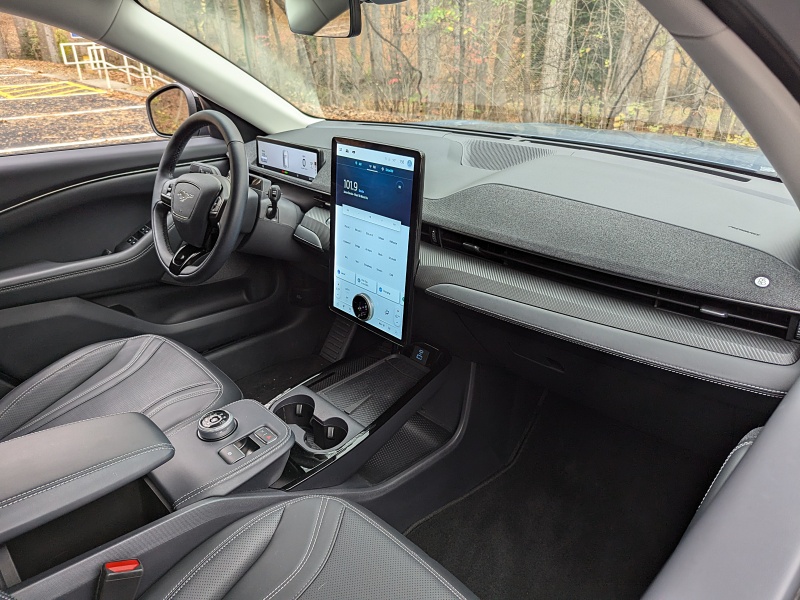
2024 Ford Mustang Mach-E Premium ・ Photo by Brady Holt
Cargo and Utility
The Mustang Mach-E also wins for cargo capacity with 29.7 cubic feet behind the rear seat and 59.7 cubic feet with the rear seat folded down. We fit luggage for a family of four, including a stroller, without folding down the Mustang’s seats.
The Ford also has a small front trunk (or “frunk”) to store a few items under the hood. The frunk shrank this year to fit the new heat pump, but the Prologue doesn’t have a frunk at all. And the Honda fits only 25.2 cubic feet behind the rear seat and 57.7 cubic feet with the rear seat folded down in base form, while upper trim levels cut that to 23.7 and 54.5 cubic feet, respectively. The Prologue is rated to tow a small 1,500-pound trailer while Ford doesn’t recommend any towing in the Mach-E, but we think the Ford’s bigger cargo hold will matter to more customers.
Winner: Ford Mustang Mach-E
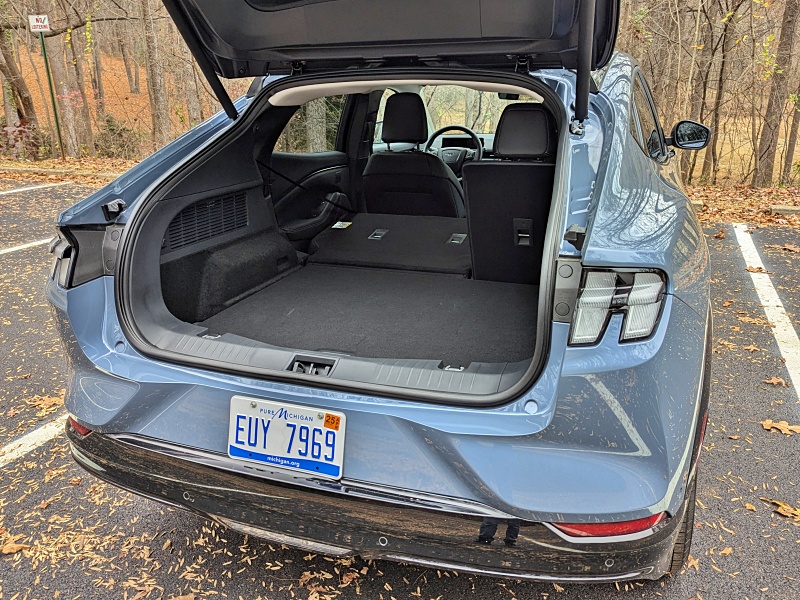
2024 Ford Mustang Mach-E Premium ・ Photo by Brady Holt
Acceleration
The Mustang name has always been about speed, and electric cars are great at delivering it. Even the base Mach-E has 264 horsepower and can zip from 0 to 60 mph in a zesty 5.6 seconds. The AWD model like our test vehicle improves to 325 hp. And if you get the extended-range battery, you get 290 hp with rear-wheel drive and 365 hp with AWD – cutting 0-60 sprints to 5.2 seconds and 4.1 seconds, respectively. And the GT and Rally models, with 480 hp, need as little as 3.3 seconds. That puts the Mach-E among the fastest cars in the world outside of a six-figure exotic. But you don’t have to drive it fast. You can use the Ford’s “Whisper” mode for gentle driving rather than the sportier-feeling Engage or Unbridled.
The Prologue takes a more leisurely approach. The AWD model like our test vehicle is still quick by most standards. It has 288 horsepower and needs about 6 seconds to hit 60 mph, which it does in drama-free near-silence. That’s quicker than most gas-powered mid-size crossovers, but it’s downright lazy next to the Mustang. And the front-wheel-drive Prologue makes just 212 hp.
Winner: Ford Mustang Mach-E
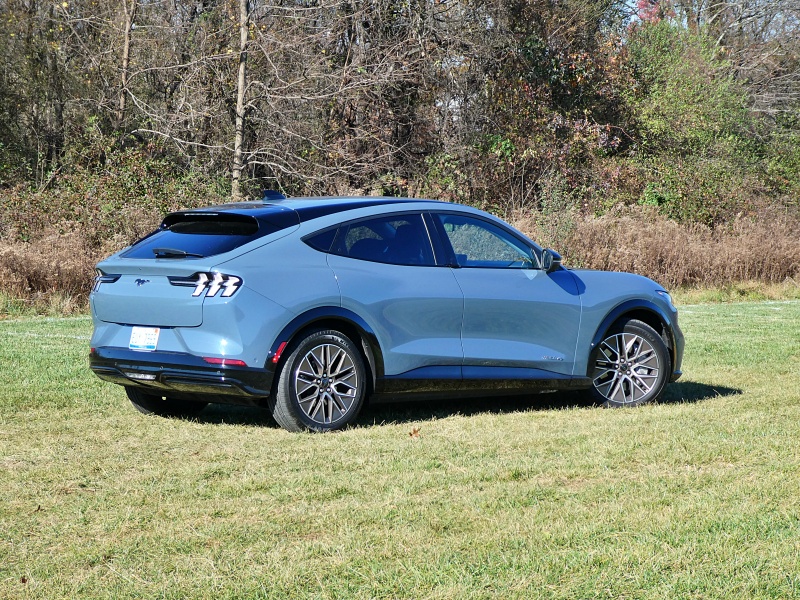
2024 Ford Mustang Mach-E Premium ・ Photo by Brady Holt
Ride and Handling
Here, too, the Mustang Mach-E is a performance car to the Prologue’s easy driver. Its suspension is well matched to the speedy acceleration, letting you confidently accelerate into fast curves. The steering is quick, almost unnaturally so, even in Whisper mode. But it’s effortlessly light at low speeds, like when you’re parking. And the ride, while firm, is comfortable.
The Prologue is a little quieter, and some people will prefer its more gradual steering responses. But overall, the Honda is less fun to drive than the Ford without being any more comfortable. It’s not bad to drive, but there isn’t the Mustang’s spark.
Winner: Ford Mustang Mach-E
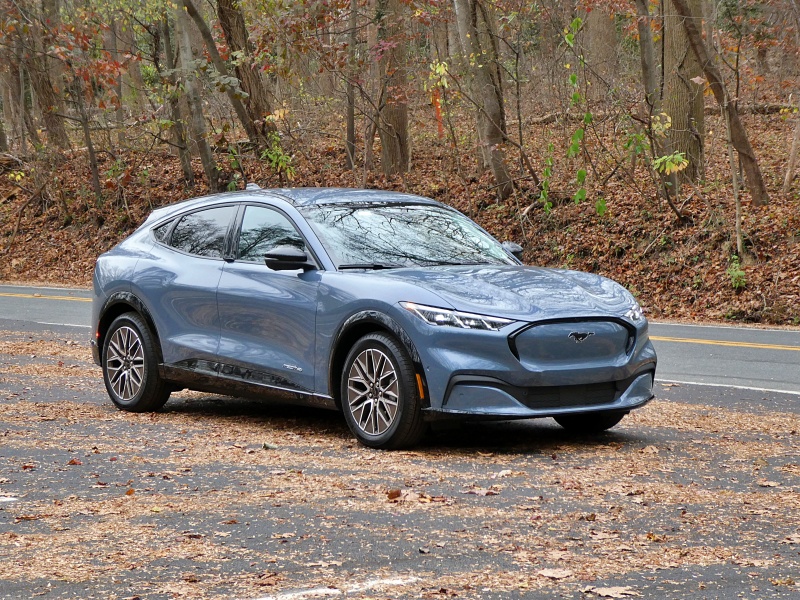
2024 Ford Mustang Mach-E Premium ・ Photo by Brady Holt
Self-Driving Features
A number of electric cars are also pioneers in self-driving technologies. This includes the Chevrolet Blazer EV, which uses GM’s hands-free Super Cruise system. However, GM didn’t pass that feature along to Honda for the Prologue. It has a less sophisticated adaptive cruise control and lane-keeping assistant – the car can accelerate, brake, and make small steering corrections automatically, but you still need to keep your hands on the steering wheel.
The Mach-E, like the Blazer EV, is at the next level. Ford's BlueCruise system invites you to take your hands off the steering wheel on 130,000 miles of pre-mapped highways – what Ford says represents 97 percent of controlled-access highways across the U.S. and Canada. The system accelerates, brakes, steers, and – new this year on the Mach-E – automatically changes lanes to overtake slower vehicles. BlueCruise is standard equipment on the Mach-E with a 90-day free trial; after that, you pay either $49.99 a month, $495 per year, or $2,495 for access as long as the system is supported (at least seven years).
Winner: Ford Mustang Mach-E
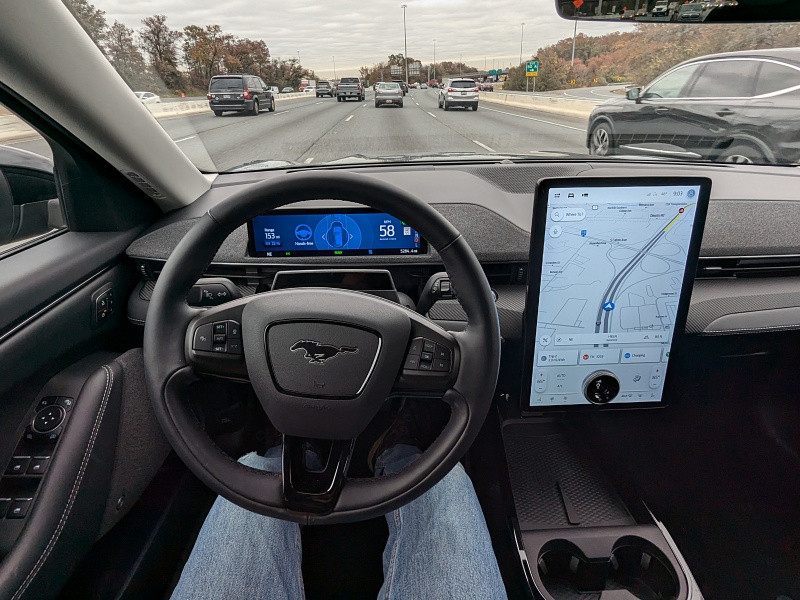
2024 Ford Mustang Mach-E BlueCruise ・ Photo by Brady Holt
Safety
The Mustang Mach-E earned the highest Top Safety Pick+ designation from the Insurance Institute for Highway Safety. Though it’s newer, the Prologue misses the IIHS’s top score for headlight illumination, automatic emergency braking, and front-passenger protection in a frontal crash test.
On the other hand, while both the Mach-E and the Prologue earned five out of five stars overall from the National Highway Traffic Safety Administration, but the Ford earned only four stars for frontal-impact protection. Both EVs have solid overall safety ratings and lots of advanced safety features, so we’ll call this category an overall tie.
Winner: Tie

2024 Honda Prologue Elite ・ Photo by Brady Holt